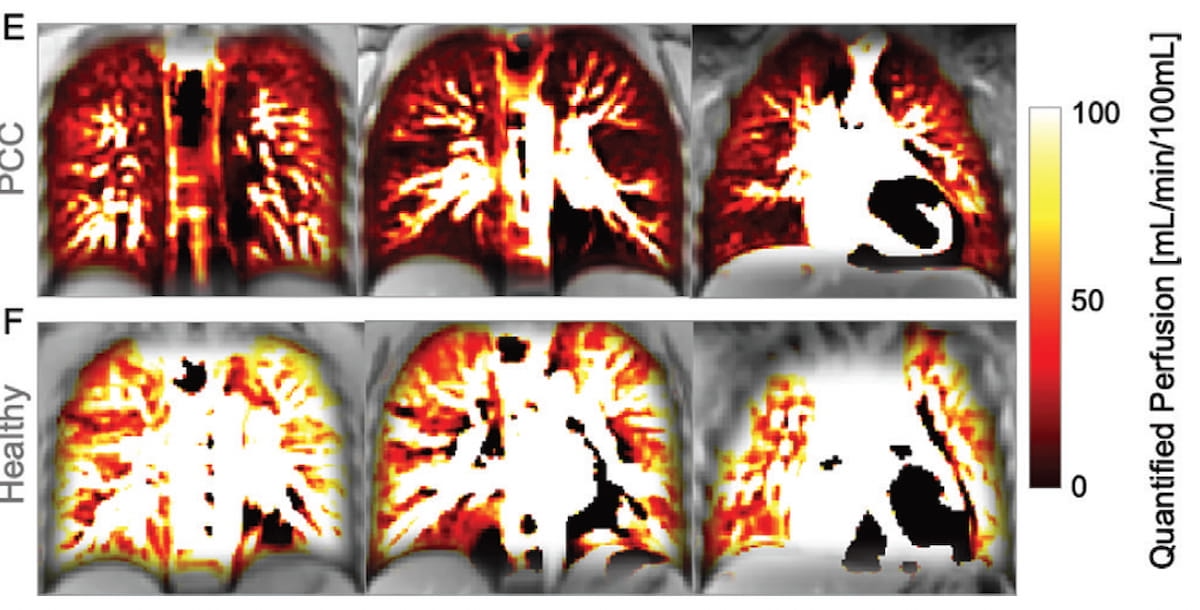Emerging research suggests that children and adolescent patients with a past history of COVID-19 may have lower quantified perfusion, higher ventilation defect and a higher percentage of perfusion defect on functional lung magnetic resonance imaging (MRI).
For the prospective study, recently published in Radiology, researchers reviewed phase-resolved functional lung MRI findings to compare 27 children and adolescents with post-COVID-19 conditions (PCC) to 27 healthy control participants. The median age of the entire cohort was 15, according to the study.
The researchers found that the study participants with PCC had lower quantified perfusion (49 mL/min per 100 mL) in comparison to healthy control participants (78 mL/min per 100 mL). The study authors also noted that those with PCC and cardiopulmonary symptoms had a higher median perfusion defect percentage (3.2 percent vs. 2.3 percent), and a higher median ventilation defect (7.6 percent vs. 5.4 percent).
Study findings also showed that fatigue was the most common clinical symptom, the only one to be noted in all participants with PCC.
“Our results showed statistically significant reductions in static ventilation (regional ventilation) and perfusion in participants with PCC compared with control participants, with lung perfusion demonstrating a positive correlation with fatigue severity,” wrote Gesa H. Pohler, M.D., who is affiliated with the Department of Diagnostic and Interventional Radiology at Hannover Medical School in Hannover, Germany, and colleagues.
In addition to fatigue, 79 percent of male study participants with PCC had shortness of breath and reduced physical activity. Fifty-three percent of female participants with PCC experienced a triad of reduced physical activity, fatigue and sleep disorders or difficulties with concentration, according to the study findings.
In comparison to healthy control participants, the study authors noted that participants with PCC had higher median heart rates (87 beats per minute vs. 79 beats per minute) and slightly higher median respiratory rates (IQR of 0.3-0.4 breaths per second vs. (IQR of 0.2-0.3 breaths per second).
“The elevated heart and respiratory rates in participants with PCC, although remaining within normal ranges, may indicate compensatory mechanisms for subclinical diastolic impairments or reflect psychologic factors, such as anxiety or stress related to the PCC diagnosis,” posited Pohler and colleagues.
Three Key Takeaways
1. Reduced lung perfusion and higher ventilation defects. Children and adolescents with post-COVID-19 conditions (PCC) had significantly lower quantified lung perfusion and higher ventilation and perfusion defects compared to healthy controls as demonstrated by functional lung MRI.
2. Fatigue as a predominant symptom. Fatigue was the most common clinical symptom, present in all participants with PCC. Additionally, shortness of breath and reduced physical activity were noted in 79 percent of male participants while over 50 percent of female participants reported a combination of fatigue, reduced activity, and cognitive or sleep disturbances.
3. Potential role of functional lung MRI. Phase-resolved functional lung MRI (PREFUL MRI) emerged as a promising, non-invasive, radiation-free imaging modality suitable for evaluating lung function in pediatric PCC patients, offering insights into pulmonary abnormalities without the need for contrast agents.
The researchers also noted that phase-resolved functional lung MRI could provide a viable imaging alternative for pediatric patients.
“Phase-resolved functional lung (PREFUL) MRI is a contrast agent–free and radiation-free imaging modality performed during free breathing that may be more suitable for children. It allows for quantification of static and dynamic regional ventilation and perfusion parameters in chronic pulmonary diseases,” maintained Pohler and colleagues.
(Editor’s note: For related content, see “New CT Angiography Study Shows Impact of COVID-19 on Coronary Inflammation and Plaque,” “MRI Long Covid Study Reveals Link Between Lower Pulmonary Gas Exchange and Cognitive Dysfunction” and “CT Study Links Pleural Effusion and Higher 30-Day Mortality Rates in Patients with COVID-19.”)
Beyond the inherent limitations of a single center study, the authors acknowledged the small cohort size and a cross-sectional design that limited evaluation of the impact of the evolution of the pulmonary abnormalities upon participant outcomes. They added that the inclusion of some participants with prior COVID-19 infection in the control cohort may have obscured clinically significant findings.
